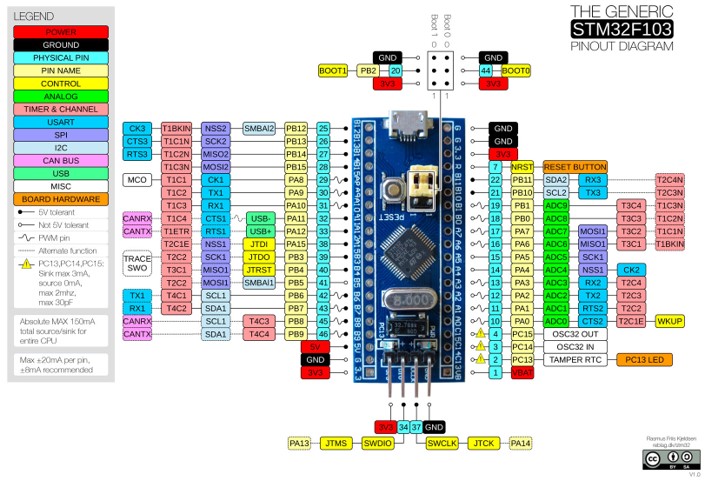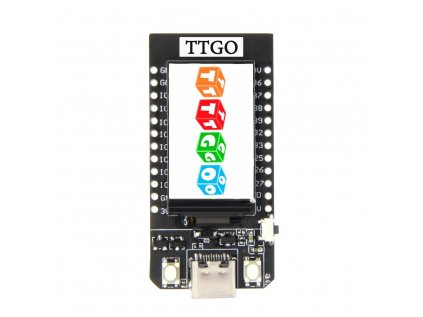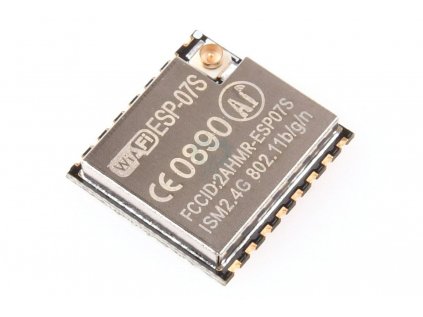BluePill ARM STM32 STM32F103C8 Development Board
Code: LA100052





Related products
Product detailed description
It is a clone of microcontroller STM32F103 - CS32F103 CPUTAPID signature 0x2ba01477. For this reason, it will not be possible to use the original GDB debugger. The chip can be designated either CS32F103 or STM32F103.
The STM32F103xx microcontroller series includes a high-performance 32-bit ARM®Cortex®-M3 RISC core operating at up to 72 MHz, high-speed embedded memories (Flash memory up to 128 kB and SRAM up to 20 kB), a rich number of enhanced I/O ports and peripherals connected to two APB buses. The microcontrollers offer two 12-bit ADCs, three universal 16-bit timers plus one PWM timer, as well as standard and advanced communication interfaces: up to two I2C and SPI, three USART, USB and CAN.
These features make the STM32F103xx series of microcontrollers suitable for a wide range of applications such as motor drives, application control, medical and handheld devices, PC and gaming peripherals, GPS platforms, industrial applications, PLCs, inverters, printers, scanners, alarm systems, videophones, and more.
With its selection of specific components and compact dimensions, this development board is very suitable for beginners who are looking for a more powerful alternative to the Arduino Nano development board. Several development environments are available for this board, including Arduino an IDE. To program the board, you can use the ST-Link V2 programmer (or its clone) or the USART Bootloader.
Specifications:
- STM32F103C8 microcontroller (clone)
- CPU frequency up to 72MHz
- FLASH 64KB
- SRAM 20KB
- 2 x 12bit ADC (0 - 3.6V, 16 channels)
- 7 x DMA
- 7 x timer:
- 3 x 16bit timers, each with up to 4 IC/OC/PWM or pulse counter inputs and a quadrature (incremental) encoder input
- 16-bit PWM timer with motor control with dead-time generation and emergency stop
- 2 x Watchdog Timer (Independent and Window)
- 24-bit SysTick timer
- 2 x I2C (SMBus/PMBus)
- 3 x USART (ISO 7816 interface, LIN, IrDA, modem control)
- 2 x SPI (18 Mbit/s)
- 1 x CAN (2.0B Active)
- 1 x USB 2.0 full-speed
- 1 x Real Time Circuit - RTC
- CRC calculation unit, 96-bit unique ID
- Oscillators, reset and power management:
- Power supply 2.0 - 3.6 V
- Power-on Reset, Power-down Reset and Programmable Voltage Detector (PVD)
- External 4 - 16 MHz oscillator for CPU
- Internal 8 MHz oscillator for CPU
- Internal 40 kHz oscillator for RTC
- PLL for CPU clocking
- External 32.768 kHz oscillator with calibration for RTC
- Low power mode:
- Sleep, Stop and Standby mode
- VBAT input for power backup for RTC and backup registers
Development board
- Plate dimensions 53mm x 22mm. Pin spacing corresponds to a standard 40pin DIP bushing - breadboard friendly
- In addition to the microcontroller, the following components are integrated on the board:
- Power source 3.3V 300mA
- 8MHz crystal for CPU
- Crystal 32.768kHz for RTC
- Programming method selection connections - BOOT0 and BOOT1
- Reset button
- Micro USB connector - power and data
- SWD connector - programming and debugging with ST-Link V2 programmer
- LED indicating 3.3V power supply
- LED connected to pin PC13
- The board can be powered using the Micro USB connector or the power pins
Connection of outlets:

Delivery components:
- 1pc Clone BluePill ARM STM32 STM32F103C8 Development Board
- 2pcs 20pin double-sided pin strip
Remark:
- The pins are not soldered in the board, but are included in the package.
- This product is not a standalone functional unit and may require professional installation.
- Product images are for illustration purposes only and may sometimes differ from the actual appearance of the item. However, this does not change its basic properties.
Additional parameters
| Category: | ARM Development Boards |
|---|---|
| Warranty: | 2 years |
| Weight: | 0.006 kg |
| Type: | ARM |
| Logical levels: | 3.3V |
| I/O pins: | 37 |
| PWM pins: | 15 |
| ADC pins: | 4 |
| Frequency: | 8MHz |
| Flash memory: | 64kB |
| SRAM memory: | 20kB |
| EEPROM memory: | Ne |
| Connector with battery charger: | No |
| Microcontroller: | STM32 |
| Converter: | No |
| Bluetooth: | No |
| WiFi: | No |
Reply
Reply
Reply
Reply








